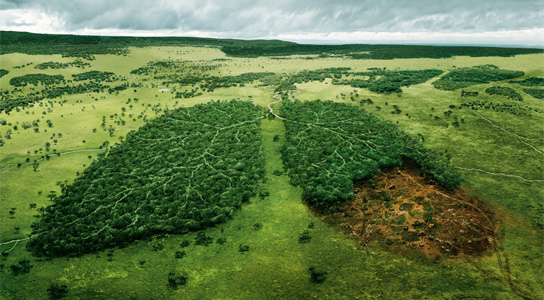In the majority of previous posts within this blog the word "afforestation" has been thrown around as a potential solution to deforestation. It has crept up in the comments section time after time and in this latest blog post I plan to explore what afforestation actually is, does it work and its impact on the deforestation discourse.
| The Next Generation (CFS) |
Afforestation and Global Climate Change
It is well known that the mighty oaks and little saplings act as a major carbon sink for planet Earth removing 3 billion tonnes of carbon each year (Canadell and Raupuch 2008). Therefore, it is vital deforested trees are replaced. Carbon dioxide released through the burning of fossil fuels worldwide is taken up by plants through the process of photosynthesis.

Whilst Canadell and Raupuch praise afforestation/reforestation processes as a solution to the global climate crisis, Bonan (2008) notes a major limit of boreal forest afforestation techniques.They have a positive feedback mechanism due to a low albedo and therefore create a warming process.
Limitations of Afforestation Practices
The main issue that is thrown around in the media is that managed reforestation and afforestation techniques will not restore the same biodiversity of the original forest. In an incredibly dated account by Stirling-Maxwell (1917) he describes the detrimental effects afforestation practices have on the environment. A devote critic of afforestation it appears, he talks about how different types of forest distinguish different regions of the world and that afforestation makes the environment more homogeneous (this opens up a whole new bag of worms surrounding "a flat world" and "the end of geography" - see the works of David Harvey and Doreen Massey). Whilst this may be true to some extent because the land is never fully returned to its original state, the same limitation of homogeneity can be applied to deforestation and Stirling-Maxwell (1917) offers no opinion on that. Wallace and Good's (1995) research into the North East of England supports Stirling-Maxwell's account of afforestation in that afforestation leads to a single more dominant species with other co-existing vegetation not being replaced.
However, Day et al. (2010) looked into afforestation on agriculture in Eastern America and noted that vegetation complementary to the dominant species (in this case oak) was grown as well to increase biodiversity. The research showed that because the seedlings and trees required consistent management for survival and growth that it was only realistic on a small scale.
The effects of afforestation vary between locations and are dependent on the techniques employed.
The Green Wall of China
Most of China's trees have been destroyed, devoured by the imperial juggernaut of urbanization, pollution and babies. The Chinese government set targets for the next 80 years but as of 2008 had made no progress in meeting them. With the help of Shanghai Roots and Shoots, a division of the Jane Goodall Institute, a total of 1 million trees have been planted to date to stop the expansion of the Gobi Desert.
China's problems do not stop there, however, as the detrimental impacts of non-native species is starting to have an effect with the non-native species removing excessive amounts of the water from groundwater causing the water table to be reduced (Window of China News)
Lets put this in perspective though - the Trees for the Future foundation has planted 35 million trees worldwide whilst the Green Belt Movement in Kenya has planted 47 million trees.
 |
| The Green Wall of China - a pipe dream? (Youtube) |
This blog post is clearly summative in its analysis of the major limitations and benefits of afforestation/reforestation with whole books dedicated to just the biodviersity impacts of these techniques. Afforestation, like most solutions, is not without its limitations. Taking away productive land from other sectors such as food production and housing for trees is clearly an issue with much debate surrounding it as we constantly fight for space. Other than reducing deforestation (a post about deforestation, policy and politics is on the horizon) afforestation and reforestation is one of the most viable and popular solutions to deforestation. Furthermore, significant afforestation could have a noticeable impact on our climate system that may have beneficial impacts on climate change - although research into this is vague and poorly understood. I see afforestation and reforestation techniques as a policy that most governments should implement on some level - Brazil's afforestation policies is shocking! - because the benefits outweigh its limitations.


